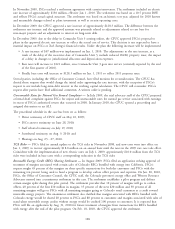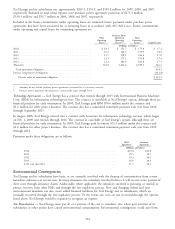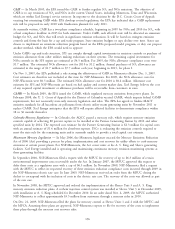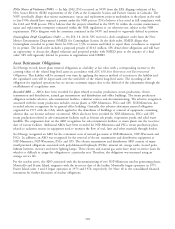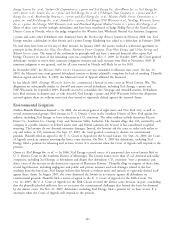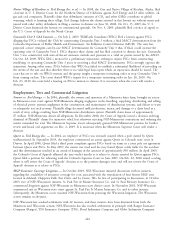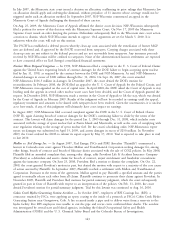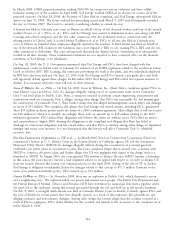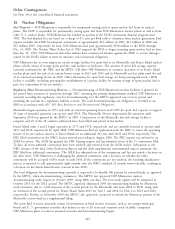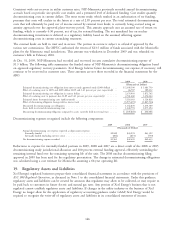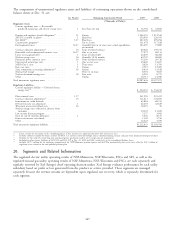Xcel Energy 2009 Annual Report Download - page 147
Download and view the complete annual report
Please find page 147 of the 2009 Xcel Energy annual report below. You can navigate through the pages in the report by either clicking on the pages listed below, or by using the keyword search tool below to find specific information within the annual report.Regional Haze Rules — In June 2005, the EPA finalized amendments to the July 1999 regional haze rules. These
amendments apply to the provisions of the regional haze rule that require emission controls, known as BART, for
industrial facilities emitting air pollutants that reduce visibility by causing or contributing to regional haze. Xcel Energy
generating facilities in several states will be subject to BART requirements.
States are required to identify the facilities that will have to reduce SO2, NOx and particulate matter emissions under
BART and then set BART emissions limits for those facilities. In May 2006, the Colorado AQCC promulgated BART
regulations requiring certain major stationary sources to evaluate and install, operate and maintain BART to make
reasonable progress toward meeting the national visibility goal. PSCo estimates that the remaining cost for
implementation of BART emission control projects is approximately $141 million in capital costs, which are included
in the capital budget.
PSCo expects the cost of any required capital investment will be recoverable from customers. Emissions controls are
expected to be installed between 2012 and 2015. Colorado’s BART state implementation plan has been submitted to
the EPA for approval. In January 2009, the CAPCD initiated a joint stakeholder process to evaluate what types of
additional NOx controls may be necessary to meet reasonable progress goals for Colorado’s Class I areas, the new ozone
standard, and Rocky Mountain National Park nitrogen deposition reduction goals. The CAPCD has indicated that it
expects to have a final plan for additional point-source NOx controls by the end of 2010.
NSP-Minnesota submitted its BART alternatives analysis for Sherco Units 1 and 2 in October 2006. The MPCA
reviewed the BART analyses for all units in Minnesota and determined that overall, compliance with CAIR is better
than BART. On Nov. 13, 2008, NSP-Minnesota submitted a revised BART alternatives analysis letter to the MPCA to
account for increased construction and equipment costs. The underlying conclusions and proposed emission control
equipment, however, remain unchanged from the original 2006 BART analysis. The MPCA completed their BART
determination and proposed SO2 and NOx limits in the draft state implementation plan (SIP) that are equivalent to
the reductions made under CAIR.
On Oct. 21, 2009, the United States Department of Interior certified that a portion of the visibility impairment in
Voyageurs and Isle Royale National Parks is reasonably attributable to pollution emissions from Xcel Energy’s Sherco
Plant Units 1 and 2. The EPA currently administers the 1980 Visibility Protection Rules for the State of Minnesota
through a Federal Implementation Plan. As such, EPA Region 5 is required to make its own determination as to
whether Sherco Units 1 and 2 cause or contribute to visibility impairment and if so, to determine the appropriate
BART levels of control.
The MPCA determined that this certification does not alter the proposed SIP. The SIP proposes BART controls for
Sherco that are designed to improve visibility in the national parks, but does not require Selective Catalytic Reduction
(SCR) on Units 1 and 2. The MPCA concluded that the minor visibility benefits derived from SCR do not outweigh
the substantial costs. On Dec. 15, 2009, the MPCA Citizens Board approved the SIP, which has been submitted to the
EPA for approval.
Federal Clean Water Act — The federal Clean Water Act requires the EPA to regulate cooling water intake structures
to assure that these structures reflect the best technology available (BTA) for minimizing adverse environmental impacts.
In July 2004, the EPA published phase II of the rule, which applies to existing cooling water intakes at steam-electric
power plants. Several lawsuits were filed against the EPA in the United States Court of Appeals for the Second Circuit
(Court of Appeals) challenging the phase II rulemaking. In January 2007, the Court of Appeals issued its decision and
remanded the rule to the EPA for reconsideration. In June 2007, the EPA suspended the deadlines and referred any
implementation to each state’s best professional judgment until the EPA is able to fully respond to the remand. In April
2008, the U. S. Supreme Court granted limited review of the Court of Appeals’ opinion to determine whether the EPA
has the authority to consider costs and benefits in assessing BTA. On April 1, 2009, the U. S. Supreme Court issued a
decision in Entergy Corp. v. Riverkeeper, Inc., concluding that the EPA can consider a cost benefit analysis when
establishing BTA. The decision overturned only one aspect of the Court of Appeals’ earlier opinion, and gives the EPA
the discretion to consider costs and benefits when it reconsiders its phase II rules. Until the EPA fully responds to the
Court of Appeals’ decision, the rule’s compliance requirements and associated deadlines will remain unknown. As such,
it is not possible to provide an accurate estimate of the overall cost of this rulemaking at this time.
The MPCA exercised its authority under best professional judgment to require the Black Dog Generating Station in its
recently renewed wastewater discharge permit to create a plan by April 2010 to reduce the plant intake’s impact on
aquatic wildlife. NSP-Minnesota is discussing alternatives with the local community and regulatory agencies to address
this concern.
137



